Yellowstone's Fly Fishing Needs Your Help,
YOUR FISHING NEEDS YOUR HELP TOO!

.. The popular press loves Gloom & Doom. It sells papers. For a bit of time they loved Whirling Disease, then Zebra Mussels, then New Zealand Mud Snails. In this neck of the woods they loved the Lake Trout. But after the gloom & doom is over they drop the topic and move on to other stories. Now NewWest has delivered us an essay with a bit of hope.
.. The gloom & doom is very real. There are threats to our fisheries, our waters, and our recreation that are with us and growing far faster than we have been able to curtail them. We have previously mentioned the Protect Your Waters Campaign. It is real, it is growing, and it needs your support.
.. Until very recently, fly fishers have believed that the spread of invasive species was a boater's problem, or a campers problem, or that someone else was to blame. This is not the case, and the alliance of fly fishers, business, and government is beginning to make progress.
+++++++++++++++++++++++
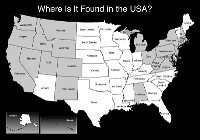
<- U.S. distribution of Whirling Disease
.. The whirling disease problem is one that has impacted trout populations from coast to coast and serves as an illustration of how the invasion works and the kind of impacts that can be expected.
.. It has been found in Yellowstone Cutthroat populations in the heart of Yellowstone National Park. This adversely impacts eagle, osprey, bear, otter, and other populations that are dependent on this once plentiful food source -- and of course, it impacts the quality of fishing. There are still things that can be done: get the facts about whirling disease.
+++++++++++++++++++++++
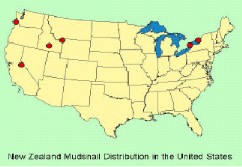
<- U.S. distribution of New Zealand Mud Snail
.. The New Zealand Mud Snail is beginning to make inroads into the premier fishing waters of the United states. It is an asexual reproducing mollusk that has already established itself in trout filled waters. It is, without a doubt, spreading toward a trout stream near you. They have just been reported in Southern California.
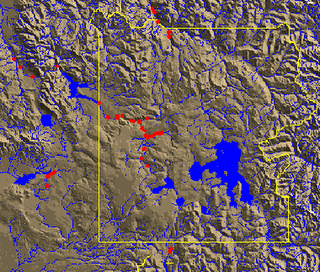
<- Yellowstone distribution of New Zealand Mud Snail
nps map
.. The documentation of this invasive species in Yellowstone National Park and the surrounding area leaves little doubt that there is a direct link between it's spread and fly fishers.
.. The snails cling to waders, ducks feet, goose feathers, boats, fly lines, etc. Because of their asexual reproduction it only takes one to start a thriving population.
.. Get the facts about this snail and what you can do.
++++++++++++++++++++++++

<- Distribution of Zebra Mussel
.. Zebra Mussels have spread from the Great Lakes, through the St Lawrence Waterway, and south, (and west,) through the Mississippi River system. They are very hardy, expand their population rapidly, and have numerous adverse affects on both the recreational and economic environment - to say nothing about the fisheries.
.. These mussels spread so rapidly that distribution maps are seldom accurate. The Zebra Mussel has just been reported upstream from Kansas City, and in Nebraska. Of course the headwaters of the Missouri River system originate in Yellowstone National Park.
.. As adults they attach themselves to just about anything. As immature forms, veligers are small - about the size of the period at the end of this sentence - and may be able to survive in any residual water source. The spread of this invasive species has attracted the attention of congress. Get the facts about what you can do about Zebra mussels.
+++++++++++++++++++

<- Lake Trout From Yellowstone Lake
nps photo
.. Lake Trout are in Yellowstone Lake and are eating tons of Yellowstone Cutthroat every year. This invasive species has remained in the news because it is a big fish and is classified as a sport fish.
.. Just as fly fishers see nothing wrong with Brown Trout and Rainbow Trout, and Brook Trout in Yellowstone waters; Midwestern fishers don't understand why this giant is a problem. Just compare the size of the fish in the photo with the largest cutthroat that you ever caught. Again, it's a question of ecosystem maintenance. Get the facts about the ongoing battle with the Lake Trout.
++++++++++++++++++++
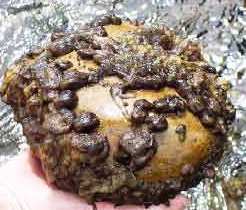
<- ROCK SNOT
.. "It doesn't matter if its animal, vegetable or mineral, but something commonly referred to as "rock snot" isn't going to be pretty." That's a fair description of this single-celled algae that is suspected in the decline of the Brown Trout fishery in Rapid Creek; and has recently been found in another Black Hills stream. The algae, called Didymosphenia geminata -- Didymo for short -- was detected in lower Castle Creek near Mystic during routine water sampling.
.. Didymo is headed our way too. It also comes from New Zealand - a popular destination with fly fishers; as is Yellowstone. This invasive species is scattered from Tennessee to the Black Hills of South Dakota where the Black Hills Fly Fishers are supporting a Canadian research project to help in the curtailment or eradication of this smothering algae. The New Zealand government is spending $12,000,000 in it's fight against this menace. We suspect that this will be the next popular headline with the gloom and doom set. Get the facts about this invasive species.
.. Read what others have to say:
** New Zealand Department Of Conservation,
** Global Invasive Species Database,
** FrogBlog,
** Invasive Species Weblog,
** Bish On Fish,
** The Scotsman,
++++++++++++++++++++++++
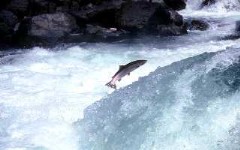 .. Sadly the notes above are just the tip of the iceberg - so to speak.
.. Sadly the notes above are just the tip of the iceberg - so to speak... Read about a new species of mud snail in California - HERE & HERE.
.. Read about the threat to Pacific Salmon & Steelhead HERE & HERE.
.. Read about Atlantic Salmon in the Pacific Waters HERE & HERE.
.. Keep up to date on ocean issues with BlogFish.
.. There are links in the sidebar to NONINDIGENOUS SPECIES sites.
.. We've activated the "Stop Aquatic Hitchhikers" link in the sidebar.
+++++++++++++++++++++++++
.. On a note of lighter weight and import: we've sent our outfitter/packer friends to the S.W. corner of Yellowstone Park. They will be there for about a week. If they survive the blood-sucking flies and mosquitoes and dudes, we will have an excellent Bechler report in six days.
.. The Gibbon River is fishing hard in the meadows but the late evening caddis hatch has produced some bruiser trout in the 16" range. Use very small elk hair caddis, (size, 14 - 18,) and aim carefully. The clear water and heavy pressure make this a very challenging & rewarding time in Elk Meadows.
.. The gulpers are going strong in the Madison Arm of Hebgan Lake. Float nymphs, (size 14 - 16,) in the evening and use emergers or spent spinner imitations in the early morning. These fish will be in pods, so spend some time to watch for feeding patterns and directions.



.jpg)






